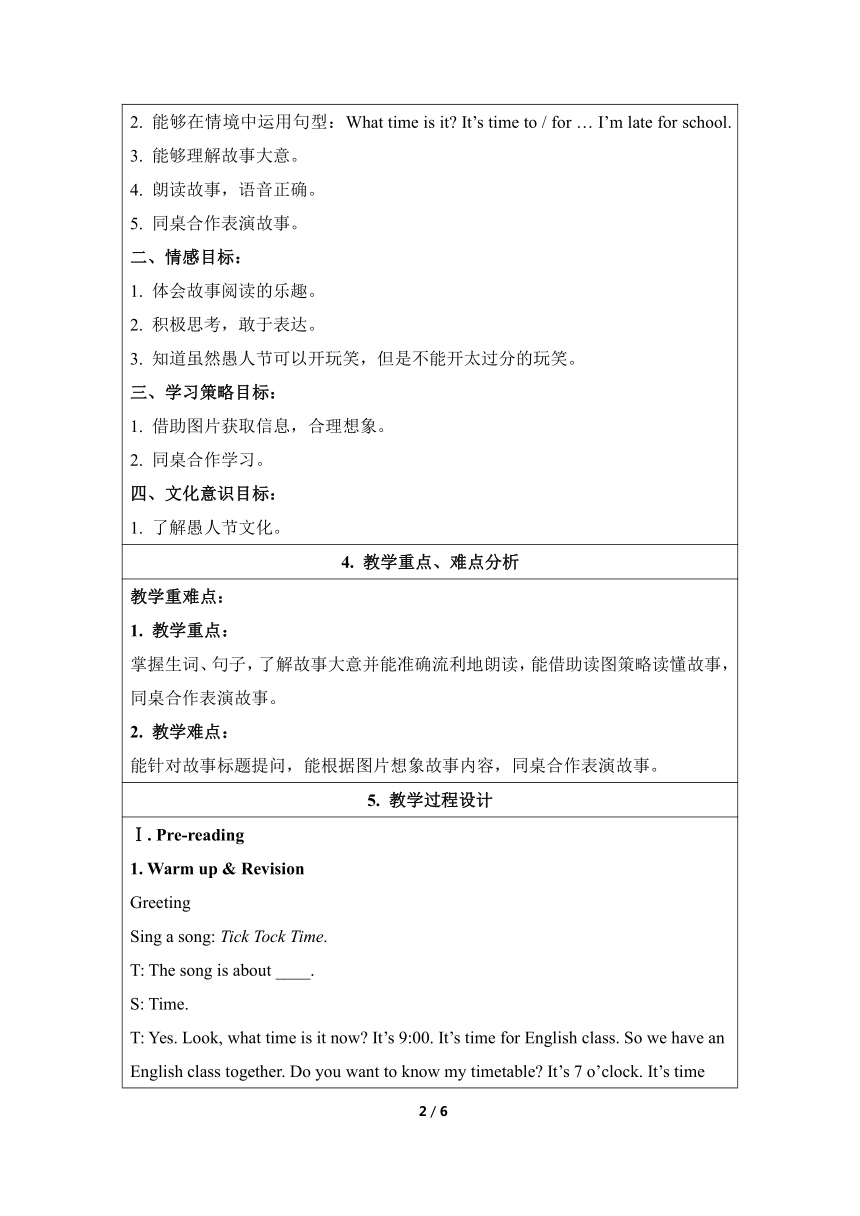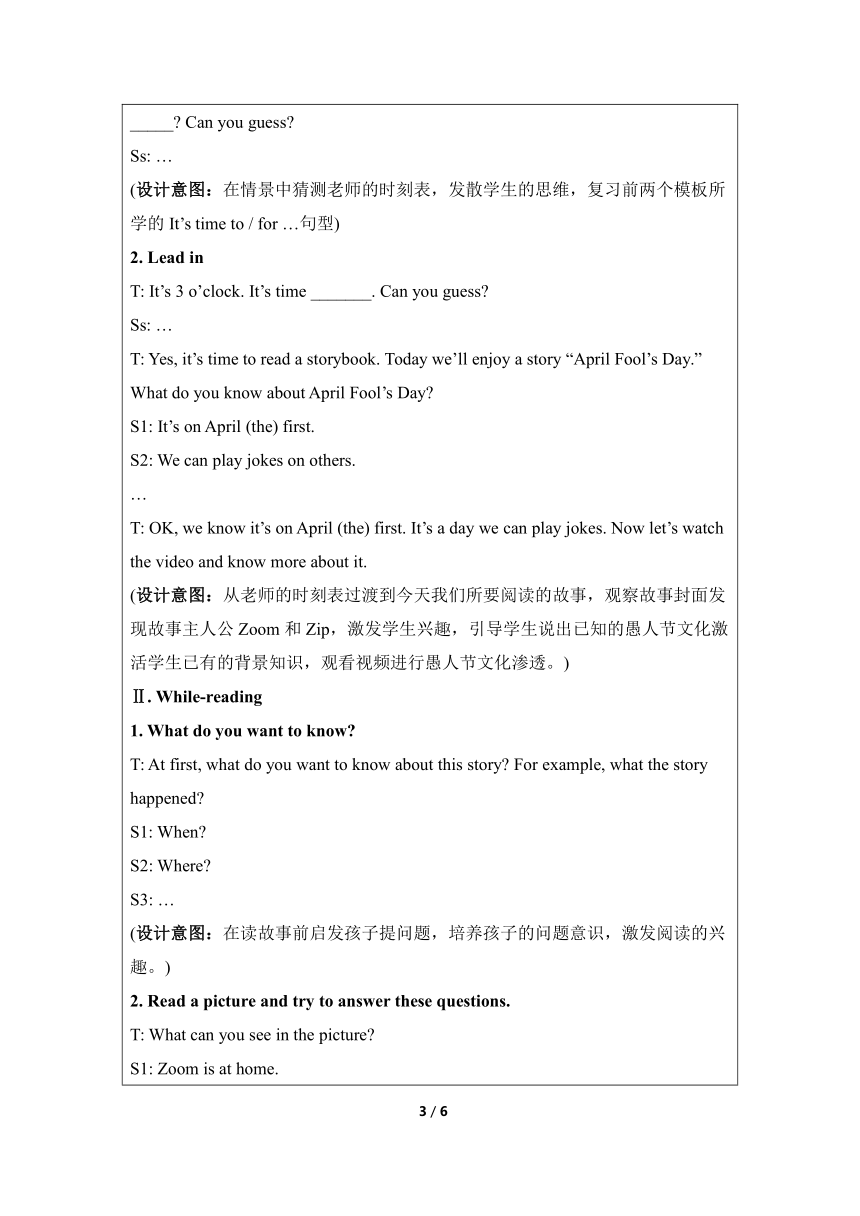Unit 2 What time is it? PC Story time 教案
文档属性
| 名称 | Unit 2 What time is it? PC Story time 教案 |  | |
| 格式 | zip | ||
| 文件大小 | 29.1KB | ||
| 资源类型 | 教案 | ||
| 版本资源 | 人教版(PEP) | ||
| 科目 | 英语 | ||
| 更新时间 | 2019-05-19 07:55:18 | ||
图片预览



文档简介
Unit2 C Story time
所教年级
四年级
所教册次、单元
四年级下册Unit2
设计主题
April Fool’s Day
1. 整体设计思路、指导依据说明
本单元选自PEP Primary English Students’ Book four Unit 2 What time is it? 本单元由三个板块构成,分别为Part A Let’s talk & Let’s Learn, Part B Let’s talk & Let’s learn, Part C Story time。本课时选自Part C,讲述了愚人节那天Zip把Zoom的闹钟调早了一个小时,愚弄Zoom的故事。四年级的孩子他们喜欢读故事,乐于表演,已经知道一些愚人节的文化,因此在课堂中以愚人节为故事背景,让学生说说已知的愚人节文化激活已有的背景知识,提出自己想知道的内容,激发孩子学习的兴趣,在故事学习中关注学生的读图能力,利用图片想象故事内容,引导孩子多提问题激活思维,理解故事大意,最终同桌合作表演故事。
2. 教学背景分析
教学内容分析:
本课选自四年级下册第二单元C Story time,本课是以愚人节为话题展开的故事,讲述了在愚人节早上Zip故意把时钟拨快了一个小时,提前叫Zoom起床。学生除了复习巩固句型What time is it? It’s time to get up.以及get up, go to school等短语以外,还要通过图片、上下文理解wake up, wait, April Fool’s Day, I’m late for school.等。同时让学生在阅读中了解愚人节的文化,并在想象的基础上理解故事,最终能够同桌合作表演故事。
学生情况分析:
学生在这一单元的前两个课时中已学过时间表达法,能提问What time is it? 并能区分运用It’s time to …/ It’s time for …等。故事体裁的文本,容易激发学生学习的兴趣,但是他们仅学过一年多的英语,语言承载量小,导致很多时候不敢开口说,不敢想象。本节课以图片为突破口,在读图的基础上引导孩子大胆想象,勇于说出自己的想法。
3. 教学目标分析
一、知识技能目标:
1. 能够听、说、认读单词:wake up, sleep, wait, April Fool’s Day, late。
2. 能够在情境中运用句型:What time is it? It’s time to / for … I’m late for school. 3. 能够理解故事大意。
4. 朗读故事,语音正确。
5. 同桌合作表演故事。
二、情感目标:
1. 体会故事阅读的乐趣。
2. 积极思考,敢于表达。
3. 知道虽然愚人节可以开玩笑,但是不能开太过分的玩笑。
三、学习策略目标:
1. 借助图片获取信息,合理想象。
2. 同桌合作学习。
四、文化意识目标:
1. 了解愚人节文化。
4. 教学重点、难点分析
教学重难点:
1. 教学重点:
掌握生词、句子,了解故事大意并能准确流利地朗读,能借助读图策略读懂故事,同桌合作表演故事。
2. 教学难点:
能针对故事标题提问,能根据图片想象故事内容,同桌合作表演故事。
5. 教学过程设计
Ⅰ. Pre-reading
1. Warm up & Revision
Greeting
Sing a song: Tick Tock Time.
T: The song is about ____.
S: Time.
T: Yes. Look, what time is it now? It’s 9:00. It’s time for English class. So we have an English class together. Do you want to know my timetable? It’s 7 o’clock. It’s time _____? Can you guess?
Ss: …
(设计意图:在情景中猜测老师的时刻表,发散学生的思维,复习前两个模板所学的It’s time to / for …句型)
2. Lead in
T: It’s 3 o’clock. It’s time _______. Can you guess?
Ss: …
T: Yes, it’s time to read a storybook. Today we’ll enjoy a story “April Fool’s Day.” What do you know about April Fool’s Day?
S1: It’s on April (the) first.
S2: We can play jokes on others.
…
T: OK, we know it’s on April (the) first. It’s a day we can play jokes. Now let’s watch the video and know more about it.
(设计意图:从老师的时刻表过渡到今天我们所要阅读的故事,观察故事封面发现故事主人公Zoom和Zip,激发学生兴趣,引导学生说出已知的愚人节文化激活学生已有的背景知识,观看视频进行愚人节文化渗透。)
Ⅱ. While-reading
1. What do you want to know?
T: At first, what do you want to know about this story? For example, what the story happened?
S1: When?
S2: Where?
S3: …
(设计意图:在读故事前启发孩子提问题,培养孩子的问题意识,激发阅读的兴趣。)
2. Read a picture and try to answer these questions.
T: What can you see in the picture?
S1: Zoom is at home.
S2: It’s 7 o’clock.
S3: …
T: What date is it? It’s April first. Now can you answer these questions? Try to think and discuss with your partners.
T: When?
S1: April first.
T: Where?
S2: Home.
T: Who?
S3: Zoom and Zip?
(设计意图:通过看故事的最后一图,了解故事的主要组成要素,引导学生抓住关键信息:时间、地点、人物……)
3. Watch and find what the story happened.
T: What happened? OK, we don’t know. Let’s watch the wordless cartoon and find what happened.
...
S: Story is about joke.
T: Joke is around us. Have you ever played jokes on others? Have you ever fooled by others? Talk it with your partner.
...
T: Let’s enjoy the funny video about joke.
T: OK, we know Zip and Zoom, they are at home, and Zip plays a joke on Zoom.
(设计意图:由于上个问题中的What在图片中还得不到解决,因而进一步引导学生观看视频了解故事内容。但是视频内容是无旁白的,学生需要边看视频边发挥想象获取故事大意,知道Zip对Zoom开了个玩笑。在视频中加深对愚人节joke文化的理解。)
4. Read the story carefully (picture by picture)
T: Yes, Zip plays a joke on Zoom. Let’s read the story in order and get more information.
① Picture1:
T: Look, Zip wakes up Zoom. (利用自然拼读的方法学习新词wake up)
T: Look, what time is it?
S1: It’s 7 o’clock.
T: It’s 7 o’clock. It’s time … Can you guess...?
② Picture 2:
T: Does Zoom get up? (Ss: No. Zoom said “Mmm, I want to sleep.) (利用自然拼读法教授新词sleep)
③ Picture3:
T: Look at the picture, guess what can Zip say?
S1: Look, what time is it?
④ Picture 4:
T: Why is Zoom so shocked? Guess!
S1: Maybe late for school.
S2: Maybe forget the homework.
S3: ...
T: Is Zoom really late? Actually, what time is it?
S1: Because Zip changes the time. Zip said: “Wait, wait, Zoom. Look at that clock.
T: Why does Zip change the time?
Ss: It’s April Fool’s Day. Zip plays a joke on Zoom.
T: Is Zoom angry?
Ss: No, because it’s on April Fool’s Day.
T: Bingo! Boys and girls, please remember we can play jokes but not too much.
(设计意图:逐图细读,理解故事内容,培养孩子读图的能力,利用图片激活学生思维,激发想象力,想象故事中的对话,想象故事内容。)
5. Read and judge
(设计意图:以判断对错的方式检测学生是否理解故事大意。)
6. Listen and imitate.
Read it loudly and emotionally by yourself.
Ⅲ. Post-reading
1. Sum up the story.
(设计意图:利用板书,对故事进行简单的小结,帮助学生梳理故事大意。)
2. Act the story out in pairs. Pay attention to the pronunciation, fluency and feelings.
(设计意图:爱表演是孩子的天性,以同桌合作的方式让学生表演故事,在表演中运用语言。)
Ⅳ. Homework
1. Read the story for 10 minutes.
2. Imagine the end of story and share it.
3. Enjoy the cartoon April Fool’s Day.
所教年级
四年级
所教册次、单元
四年级下册Unit2
设计主题
April Fool’s Day
1. 整体设计思路、指导依据说明
本单元选自PEP Primary English Students’ Book four Unit 2 What time is it? 本单元由三个板块构成,分别为Part A Let’s talk & Let’s Learn, Part B Let’s talk & Let’s learn, Part C Story time。本课时选自Part C,讲述了愚人节那天Zip把Zoom的闹钟调早了一个小时,愚弄Zoom的故事。四年级的孩子他们喜欢读故事,乐于表演,已经知道一些愚人节的文化,因此在课堂中以愚人节为故事背景,让学生说说已知的愚人节文化激活已有的背景知识,提出自己想知道的内容,激发孩子学习的兴趣,在故事学习中关注学生的读图能力,利用图片想象故事内容,引导孩子多提问题激活思维,理解故事大意,最终同桌合作表演故事。
2. 教学背景分析
教学内容分析:
本课选自四年级下册第二单元C Story time,本课是以愚人节为话题展开的故事,讲述了在愚人节早上Zip故意把时钟拨快了一个小时,提前叫Zoom起床。学生除了复习巩固句型What time is it? It’s time to get up.以及get up, go to school等短语以外,还要通过图片、上下文理解wake up, wait, April Fool’s Day, I’m late for school.等。同时让学生在阅读中了解愚人节的文化,并在想象的基础上理解故事,最终能够同桌合作表演故事。
学生情况分析:
学生在这一单元的前两个课时中已学过时间表达法,能提问What time is it? 并能区分运用It’s time to …/ It’s time for …等。故事体裁的文本,容易激发学生学习的兴趣,但是他们仅学过一年多的英语,语言承载量小,导致很多时候不敢开口说,不敢想象。本节课以图片为突破口,在读图的基础上引导孩子大胆想象,勇于说出自己的想法。
3. 教学目标分析
一、知识技能目标:
1. 能够听、说、认读单词:wake up, sleep, wait, April Fool’s Day, late。
2. 能够在情境中运用句型:What time is it? It’s time to / for … I’m late for school. 3. 能够理解故事大意。
4. 朗读故事,语音正确。
5. 同桌合作表演故事。
二、情感目标:
1. 体会故事阅读的乐趣。
2. 积极思考,敢于表达。
3. 知道虽然愚人节可以开玩笑,但是不能开太过分的玩笑。
三、学习策略目标:
1. 借助图片获取信息,合理想象。
2. 同桌合作学习。
四、文化意识目标:
1. 了解愚人节文化。
4. 教学重点、难点分析
教学重难点:
1. 教学重点:
掌握生词、句子,了解故事大意并能准确流利地朗读,能借助读图策略读懂故事,同桌合作表演故事。
2. 教学难点:
能针对故事标题提问,能根据图片想象故事内容,同桌合作表演故事。
5. 教学过程设计
Ⅰ. Pre-reading
1. Warm up & Revision
Greeting
Sing a song: Tick Tock Time.
T: The song is about ____.
S: Time.
T: Yes. Look, what time is it now? It’s 9:00. It’s time for English class. So we have an English class together. Do you want to know my timetable? It’s 7 o’clock. It’s time _____? Can you guess?
Ss: …
(设计意图:在情景中猜测老师的时刻表,发散学生的思维,复习前两个模板所学的It’s time to / for …句型)
2. Lead in
T: It’s 3 o’clock. It’s time _______. Can you guess?
Ss: …
T: Yes, it’s time to read a storybook. Today we’ll enjoy a story “April Fool’s Day.” What do you know about April Fool’s Day?
S1: It’s on April (the) first.
S2: We can play jokes on others.
…
T: OK, we know it’s on April (the) first. It’s a day we can play jokes. Now let’s watch the video and know more about it.
(设计意图:从老师的时刻表过渡到今天我们所要阅读的故事,观察故事封面发现故事主人公Zoom和Zip,激发学生兴趣,引导学生说出已知的愚人节文化激活学生已有的背景知识,观看视频进行愚人节文化渗透。)
Ⅱ. While-reading
1. What do you want to know?
T: At first, what do you want to know about this story? For example, what the story happened?
S1: When?
S2: Where?
S3: …
(设计意图:在读故事前启发孩子提问题,培养孩子的问题意识,激发阅读的兴趣。)
2. Read a picture and try to answer these questions.
T: What can you see in the picture?
S1: Zoom is at home.
S2: It’s 7 o’clock.
S3: …
T: What date is it? It’s April first. Now can you answer these questions? Try to think and discuss with your partners.
T: When?
S1: April first.
T: Where?
S2: Home.
T: Who?
S3: Zoom and Zip?
(设计意图:通过看故事的最后一图,了解故事的主要组成要素,引导学生抓住关键信息:时间、地点、人物……)
3. Watch and find what the story happened.
T: What happened? OK, we don’t know. Let’s watch the wordless cartoon and find what happened.
...
S: Story is about joke.
T: Joke is around us. Have you ever played jokes on others? Have you ever fooled by others? Talk it with your partner.
...
T: Let’s enjoy the funny video about joke.
T: OK, we know Zip and Zoom, they are at home, and Zip plays a joke on Zoom.
(设计意图:由于上个问题中的What在图片中还得不到解决,因而进一步引导学生观看视频了解故事内容。但是视频内容是无旁白的,学生需要边看视频边发挥想象获取故事大意,知道Zip对Zoom开了个玩笑。在视频中加深对愚人节joke文化的理解。)
4. Read the story carefully (picture by picture)
T: Yes, Zip plays a joke on Zoom. Let’s read the story in order and get more information.
① Picture1:
T: Look, Zip wakes up Zoom. (利用自然拼读的方法学习新词wake up)
T: Look, what time is it?
S1: It’s 7 o’clock.
T: It’s 7 o’clock. It’s time … Can you guess...?
② Picture 2:
T: Does Zoom get up? (Ss: No. Zoom said “Mmm, I want to sleep.) (利用自然拼读法教授新词sleep)
③ Picture3:
T: Look at the picture, guess what can Zip say?
S1: Look, what time is it?
④ Picture 4:
T: Why is Zoom so shocked? Guess!
S1: Maybe late for school.
S2: Maybe forget the homework.
S3: ...
T: Is Zoom really late? Actually, what time is it?
S1: Because Zip changes the time. Zip said: “Wait, wait, Zoom. Look at that clock.
T: Why does Zip change the time?
Ss: It’s April Fool’s Day. Zip plays a joke on Zoom.
T: Is Zoom angry?
Ss: No, because it’s on April Fool’s Day.
T: Bingo! Boys and girls, please remember we can play jokes but not too much.
(设计意图:逐图细读,理解故事内容,培养孩子读图的能力,利用图片激活学生思维,激发想象力,想象故事中的对话,想象故事内容。)
5. Read and judge
(设计意图:以判断对错的方式检测学生是否理解故事大意。)
6. Listen and imitate.
Read it loudly and emotionally by yourself.
Ⅲ. Post-reading
1. Sum up the story.
(设计意图:利用板书,对故事进行简单的小结,帮助学生梳理故事大意。)
2. Act the story out in pairs. Pay attention to the pronunciation, fluency and feelings.
(设计意图:爱表演是孩子的天性,以同桌合作的方式让学生表演故事,在表演中运用语言。)
Ⅳ. Homework
1. Read the story for 10 minutes.
2. Imagine the end of story and share it.
3. Enjoy the cartoon April Fool’s Day.
